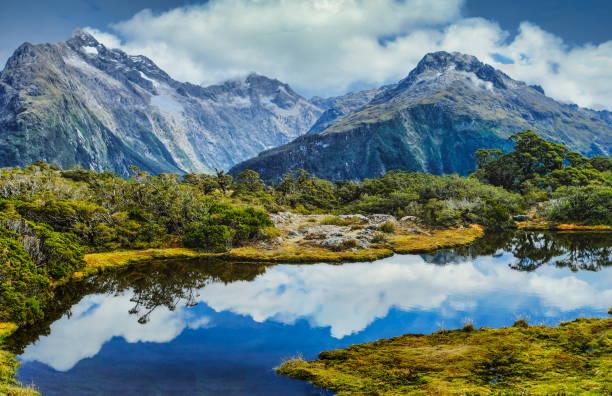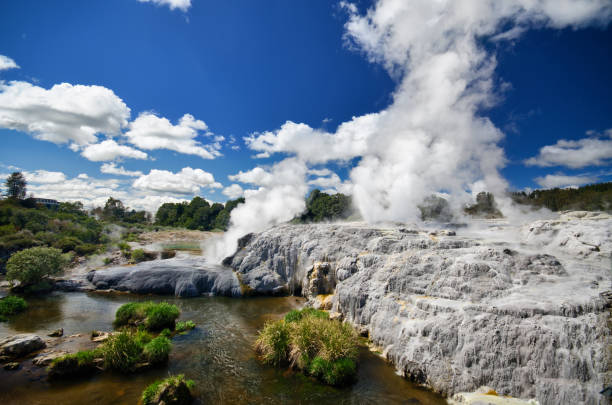Fiordland National Park: A Natural Wonder in New Zealand
Fiordland National Park, nestled on the South Island of New Zealand, is a pristine and enchanting destination that captivates the hearts of travelers from all corners of the globe. Covering a vast expanse of 12,607 square kilometers, this national park is renowned for its dramatic fjords, lush rainforests, and unparalleled natural beauty. It is often considered one of the most breathtaking wilderness areas in the world and holds a special place in the hearts of those who visit. In this article, we will delve into the awe-inspiring wonders of Fiordland National Park, exploring its unique geography, diverse ecosystems, and the myriad of experiences it offers to travelers.
The Geological Marvel of Fiordland
At the heart of Fiordland National Park’s allure lies its remarkable geological history. The rugged landscape is shaped by ancient glaciers and tectonic forces, which have created a landscape of extraordinary beauty. The park boasts a unique system of fourteen fiords, each with its distinct character and charm. Among the most famous are Milford Sound and Doubtful Sound, both of which leave visitors in awe of their grandeur.
Milford Sound, sometimes called the “Eighth Wonder of the World,” is a fiord renowned for its breathtaking scenery. Towering granite cliffs, some rising over a mile high, surround the tranquil waters. Powerful waterfalls cascade down these cliffs, creating a mesmerizing symphony of nature. Visitors can embark on boat cruises to navigate the serene waters and be enveloped by the dramatic landscapes. Additionally, Milford Track, one of New Zealand’s Great Walks, offers a world-class hiking experience for those who wish to immerse themselves in the park’s wilderness on foot.
Doubtful Sound, the second-largest of the fiords, offers a more secluded and untouched experience. Accessible via boat tours from nearby Manapouri, it enchants visitors with its deep, dark waters, steep cliffs, and dense rainforests. The sound’s remote and pristine nature allows travelers to feel like they are truly exploring an unspoiled wilderness.
The fiords are just one facet of Fiordland’s geological wonders. The park also features remarkable sea cliffs, ancient valleys, and glacially carved landscapes that provide endless opportunities for photographers, hikers, and nature enthusiasts to marvel at the earth’s ever-evolving canvas.
Diverse Ecosystems and Wildlife
Fiordland National Park’s diverse ecosystems support a wide range of wildlife and plant species, many of which are unique to this region. The lush rainforests, clear lakes, and pristine rivers make it a haven for biodiversity. In particular, the park is home to several threatened and endangered species.
One of the most notable inhabitants is the native and flightless takahe, a large, vibrant blue bird with a remarkable history of near-extinction and rediscovery. The park’s dense forests are filled with the melodious calls of native birds like the tui, bellbird, and the famous kea parrot. The Fiordland crested penguin is another star attraction, and visitors often catch glimpses of these charming, waddling creatures.
Fiordland’s aquatic ecosystems are equally fascinating. The park’s clear waters house a variety of fish species, including the unique white bait, a popular Kiwi delicacy. The pristine lakes are also home to brown and rainbow trout, making the region a favorite among anglers.
The waters of Fiordland are teeming with marine life, too. Fur seals, dolphins, and even the elusive and majestic southern right whale can be spotted in the fiords. This combination of terrestrial and marine ecosystems makes Fiordland National Park an ecological treasure trove that continues to astound scientists and nature enthusiasts alike.
Hiking and Outdoor Adventures
For those who relish outdoor adventures and exploration, Fiordland National Park offers a wide array of activities to choose from. Hiking, or tramping as it’s known in New Zealand, is particularly popular. The park features a network of trails that cater to various skill levels and interests.
In addition to the aforementioned Milford Track, which is a world-famous multi-day hiking route, the Kepler Track and Routeburn Track are also part of New Zealand’s Great Walks and provide an opportunity for multi-day journeys through the park’s pristine wilderness. These hikes offer a chance to experience stunning landscapes, from emerald lakes and mossy beech forests to high mountain passes with breathtaking views.
For day-trippers, there are numerous shorter hikes that allow you to explore the park’s beauty without committing to an extended trek. The Key Summit Track, for instance, is a popular option that takes you through diverse alpine ecosystems and offers panoramic views of the Darran Mountains.
Water-based activities are another exciting aspect of Fiordland’s adventures. Kayaking, boating, and scenic cruises are excellent ways to experience the fiords up close. Many visitors choose to explore the dark, still waters of Doubtful Sound or Milford Sound by kayak, providing an intimate encounter with the fiords and the creatures that inhabit them.
Conservation and Preservation
Fiordland National Park’s natural wonders are not only preserved but also continuously studied and protected. The park is part of the larger Te Wahipounamu UNESCO World Heritage Area, recognized for its significant natural and cultural values. Conservation efforts in Fiordland are extensive, aiming to maintain the park’s unique ecosystems and safeguard its native species.
One of the major challenges in the park’s preservation is the control of introduced predators. The Department of Conservation (DOC) has been actively working to eradicate pests like stoats, rats, and possums that threaten the park’s indigenous wildlife. This conservation effort is critical to maintaining the delicate balance of the ecosystem and ensuring the continued existence of native species.
Cultural Significance and Indigenous Connections
In addition to its natural beauty, Fiordland National Park also holds cultural and spiritual significance for the indigenous Māori people of New Zealand. The park’s Māori name, “Te Moana o Atawhenua,” reflects its deep connection to the land and the people.
Māori legends and stories are intertwined with the landscapes of Fiordland, with the fiords themselves often believed to be the work of a demigod named Tuterakiwhanoa. Māori traditions and values are respected and acknowledged within the park, adding depth to the visitor experience.
Visitors to Fiordland have the opportunity to engage with Māori culture through guided tours and experiences that showcase traditional storytelling, music, and dance. These experiences help to bridge the gap between the natural wonders of the park and the rich cultural tapestry of New Zealand.
Conclusion
Fiordland National Park stands as a testament to the extraordinary beauty and ecological significance of New Zealand’s South Island. Its grandeur is a powerful reminder of the forces of nature that have shaped our planet over millennia, and it continues to be a source of wonder and inspiration for all who visit.
Whether you are drawn to its majestic fiords, the vibrant ecosystems, or the countless outdoor adventures it offers, Fiordland National Park is a destination that beckons to nature enthusiasts, hikers, photographers, and all who seek to immerse themselves in the awe-inspiring beauty of our world. As a place of natural wonder and ecological importance, it is a treasure for both New Zealand and the global community. For those fortunate enough to experience its

